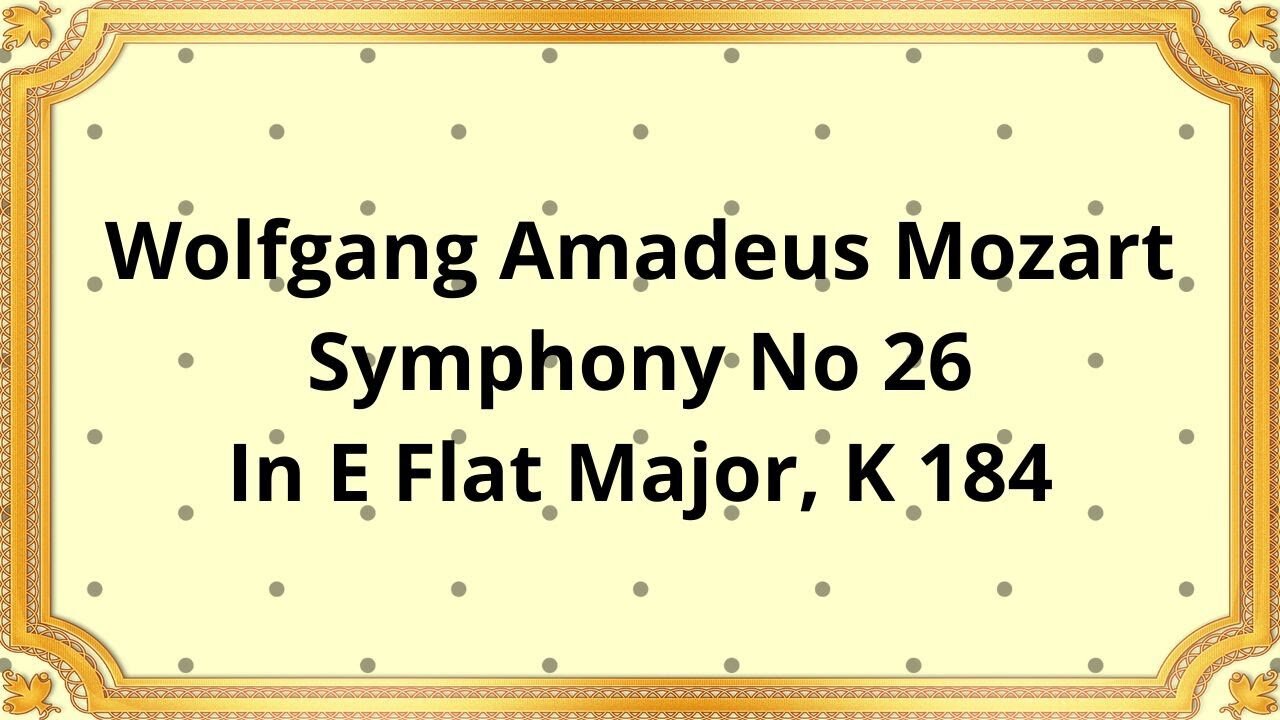Premium Only Content

Wolfgang Amadeus Mozart Symphony No 26 In E Flat Major, K 184
#Mozart#Chamber_music#Classical_music#Symphony#Musical_composition
Publication date 1953
Louis Kaufman, Violinist
Netherlands Philharmonic Orchestra
Otto Ackermann, Conductor
Wolfgang Amadeus Mozart Symphony No. 26 in E-flat Major, K. 184, is a stunning piece of classical music that was composed by the legendary Austrian composer, Wolfgang Amadeus Mozart. This symphony is one of the early works of Mozart and was composed in 1773 when he was just 17 years old.
The Symphony No. 26 is scored for two oboes, two horns, and strings. It is in three movements, with the first and last movements in the key of E-flat major, while the second movement is in C minor. The symphony is known for its beautiful melodies, harmonic structure, and use of counterpoint.
The first movement of the symphony, marked "Molto presto," is a lively and spirited piece that showcases Mozart's talent for creating catchy and memorable melodies. The opening theme is introduced by the strings and is then repeated by the oboes and horns. The development section of the movement features intricate counterpoint and virtuosic solo passages for the oboes and horns.
The second movement, marked "Andante," is a stark contrast to the first movement, with a somber and melancholic tone. The movement is in C minor, a key that Mozart often used to convey sadness and tragedy. The main theme is introduced by the strings and is then passed on to the oboe, who plays a beautiful solo.
The final movement, marked "Molto Allegro," is a joyous and uplifting piece that brings the symphony to a rousing conclusion. The movement features rapid-fire rhythms and virtuosic solo passages for the oboes and horns.
Overall, the Symphony No. 26 is an excellent example of Mozart's early style, characterized by lively melodies, intricate counterpoint, and virtuosic solo passages. The symphony is also a testament to Mozart's prodigious talent, as he was able to compose such a masterpiece at such a young age.
In terms of its historical context, the Symphony No. 26 was composed during a time of great change in classical music. The symphony is often classified as belonging to the "Mannheim School," a group of composers who were known for their use of dynamic contrasts, expressive melodies, and virtuosic solo passages.
In conclusion, Wolfgang Amadeus Mozart's Symphony No. 26 in E-flat Major, K. 184, is a masterpiece of classical music that showcases Mozart's prodigious talent and early style. Its catchy melodies, intricate counterpoint, and virtuosic solo passages make it a must-listen for any lover of classical music.
-
 31:06
31:06
Classical music_Music Inspiration
1 month agoPyotr Ilyich Tchaikovsky Piano Concerto No. 1 in B-flat minor
571 -
 DVR
DVR
Man in America
12 hours agoInflation, Debt & War: The 2032 Crash Cycle Is Here—Nations Will FALL w/ Martin Armstrong
11.5K9 -
 LIVE
LIVE
Adam Does Movies
11 hours agoTalking Movies + Ask Me Anything - LIVE
161 watching -
 2:55:43
2:55:43
TimcastIRL
4 hours agoTrump DOJ To Ban Trans People From Owning Guns After Catholic School Shooting | Timcast IRL
149K85 -
 LIVE
LIVE
The Quartering
3 hours agoBaldur's Gate 3 First Playthrough!
728 watching -
 LIVE
LIVE
Rallied
5 hours ago $0.22 earnedWarzone Solo Challenges
349 watching -
 57:40
57:40
MattMorseTV
5 hours ago $0.21 earned🔴Trump just SHATTERED the RECORD.🔴
39.1K77 -
 43:39
43:39
WickedVirtue
2 hours agoLate Night Spooky Plays
12K -
 2:04:02
2:04:02
Glenn Greenwald
5 hours agoTrump and Rubio Apply Panama Regime Change Playbook to Venezuela; Michael Tracey is Kicked-Out of Epstein Press Conference; RFK Senate Hearing | SYSTEM UPDATE #508
91.9K102 -
 58:36
58:36
Total Horse Channel
7 hours ago2025 CSI3* A Coruña Porsche - Grand Prix
18.5K